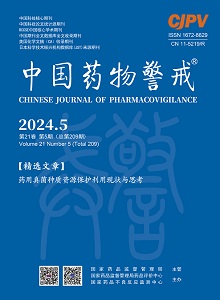|
|
Mechanisms of extracts of Pith-nodecayed and Pith-decayed of Scutellariae Radix against Th17/Treg immune imbalance in damp-heat ulcerative colitis rats
HUANG Wei, LUO Yaqin, YU Xinyang, DONG Hongjing, WANG Xiao
2024, 21(5):
535-539.
DOI: 10.19803/j.1672-8629.20230566
Objective To compare the effects of extracts from Pith-decayed and Pith-nodecayed products of Scutellariae Radix on expressions of helper T cell 17 (Th17)/regulatory T cell (Treg) cytokines and the transcription factor ROR-γt/ Foxp3 in rats with damp-heat ulcerative colitis (UC). Methods Fifty healthy SD rats were randomly divided into five groups: the normal group, model group, Pith-decayed products of Scutellariae Radix group, Pith-nodecayed products of Scutellariae Radix group and mesalazine group, with 10 rats in each. A damp-heat UC rat model was established via the combination of high-fat and high-sugar diet+high-liquor administration+5% dextran sodium sulfate (DSS). Each group was given intragastric administration on the first day of modeling, respectively. The dosage was 5.25 g·kg-1·d-1 for the Pith-decayed products group and Pith-nodecayed products group, but 0.266 g·kg-1·d-1 for the mesalazine group. The normal group and model group were given an equal volume of normal saline. The drug was administered for 28 consecutive days. After administration, the rats were anesthetized, blood was collected from the abdominal aorta, serum was separated, and serum levels of interleukin-6(IL-6), IL-17A, IL-10 and transforming growth factor-β1(TGF-β1) were detected by Elisa. Spleen and colon tissues were separated, the proportion of Th17 and Treg cells in spleens was detected by flow cytometry, and the Th17/Treg ratio was calculated. Real-time quantitative fluorescent polymerase chain reaction (qRT-PCR) was used to detect the mRNA expression levels of ROR-γt and Foxp3 in colon tissues. The expression levels of ROR-γt and Foxp3 in colon tissues were detected by Western blot. Results Compared with the normal group, serum levels of IL-6 and IL-17A, the proportion of Th17 cells in spleens, Th17/Treg, and mRNA and protein expression levels of ROR-γt in colon tissues of the model group were significantly increased (P<0.01) while serum levels of IL-10, IL-35, TGF-β1, the proportion of Treg cells in spleens and the expression of Foxp3 mRNA and protein in colon tissues were significantly decreased (P<0.01). After 28 days of administration, serum levels of IL-6, IL-17A, the Th17 cell ratio in spleens, Th17/Treg, and ROR-γt mRNA and protein expression levels in colon tissues of rats in each administration group were decreased to varying degrees compared with the model group (P<0.05 or P<0.01), while serum levels of IL-10, IL-35, TGF-β1, the proportion of Treg cells in spleens, and the expression of Foxp3 mRNA and protein in colon tissues were increased to different extents (P<0.05 or P<0.01). Compared with the Pith-decayed products of Scutellariae Radix group, Pith-nodecayed products of Scutellariae Radix group and mesalazine group were more effective in reducing levels of IL-6 and IL-17A, increasing levels of IL-10, IL-35 and TGF-β1, and regulating mRNA and protein expressions of ROR-γt (P<0.05 or P<0.01). Conclusion Pith-decayed and Pith-nodecayed products of Scutellariae Radix may help regulate the expressions of transcription factors ROR-γt and Foxp3, restore Th17 /Treg immune imbalance, inhibit inflammatory response, protect against intestinal mucosal barrier damage, and facilitate the treatment of damp-heat UC.
References |
Related Articles |
Metrics
|
